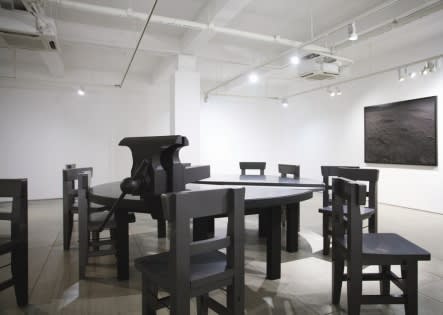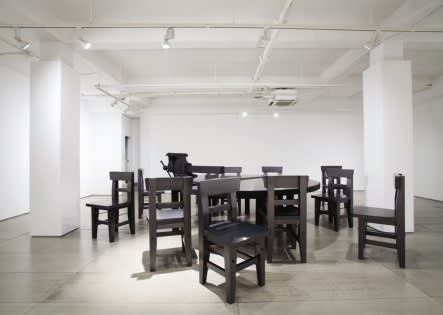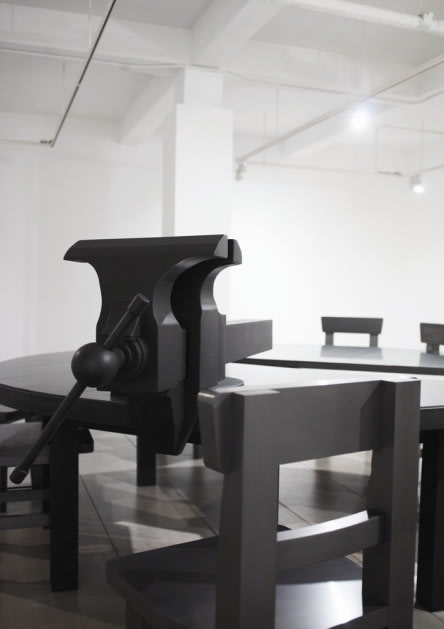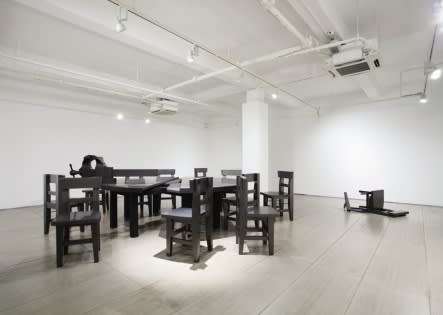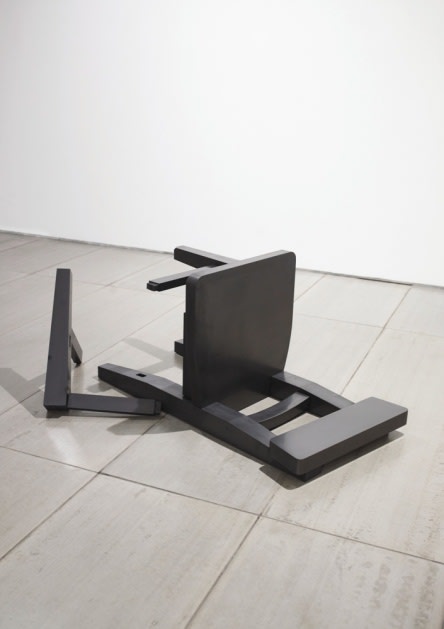PARK Jongbin: Into the Membrane
Period | 02 March – 30 March, 2011
Venue | Arario Gallery Seoul samcheong
Works | 07 pieces including installation, sculpture and photography
Opening Reception | 6pm Wednesday, 02 March, 2011
Sculptor Chongbin Park (b. 1972), who has been working in UK, holds a solo exhibition at Arario Gallery, Seoul. This exhibition, which is his first solo in Korea since his last solo exhibition which took place in London in 2007, introduces table and chairs sculptures made of graphite, photographs and so on.
Chongbin Park has been using graphite for his work since 2007. Looking at him, which he produced in UK in 2007, was a huge sculpture of a Doberman, the surface intricately painted with graphite on the cardboard. This huge canine, towering over a fully grown adult, has a very minimalistic shape like a robot or a toy; the graphite-painted surface gives off the texture of steel rather than paper.
The artist made full use of graphite for this solo exhibition. In his large-sized sculpture installation Domestic Occasion (2010), a composite of vices (used to fixate objects in the process of sculpting), twelve chairs and a wide table, the upper board of the table and chairs are all made of graphite. The graphite table and chairs, their surface minutely and intricately sculpted over time, appear to be made of hard and heavy steel, but are in fact so subtle that they may easily fall apart or be chipped even by the slightest impact.
The huge table and the twelve chairs fill up the entire exhibition space, exuding a claustrophobic fullness all viewers might sense the moment they walk into the gallery. The cracks in the table are meticulously jointed, forming a hard circle, and the chairs surrounding the table also look as if everything has been perfectly coordinated. The heavy table and chairs remind the viewers of elementary school chairs, or tables one might see in living rooms or kitchens. Or, they could be round conference tables. The artist is showing how systems such as families or schools could at once be protective or formative forces for individuals, and also become shackles with their oppressive and forceful presence, by using objects made of graphite, a material that appears to be hard but is in fact very sensitive and fragile.
The table-chair set is repeated in another sculpture titled Closed Passage (2010-2011), in the form of a miniature. The table-chair miniatures are placed inside a cross-like structure, which reminds one of a transept (a cross section that connects the altar and nave in a cross-figured cathedral in Western countries). The view is obscured by a semi-transparent vinyl cover; the table and chairs are scattered about, giving only a glimpse of their arrangements.
This repetition in varied sizes comes to its conclusion in Dust Room (2010-2011), into which Closed Passage is inserted as a miniature. Dust Room is based on a device used for physics or chemical experiments; the experimented object is locked in the device, to which various variables are applied and the figures can be repeatedly confirmed. Using the device, the artist generates dust with regular intervals within the box, and shows the viewers how the yellow walls and equipments in the device are gradually covered with the dust.
Along with the various sculptures, photographs of soft graphite dust, the spots and textures of look almost like waves or barren deserts. The artist shaved off huge, heavy graphite masses in the process of creating Domestic Occasion, endowing the graphite surface with steel-like sheens. This repetitive act, conducted over long periods, can be looked upon as structural, but also meaningless. While shaving out the graphite, the artist began to collect the graphite dust and particles covering the studio. His idea was that the dust and particles that absorb the pressure of grinding and scrubbing, are the very proofs of such pressures. The artist is telling us that the dust we see all around us can be testimonies to the time, place and sentiments involving various pressures we as individuals ceaselessly face, whether they be internal beliefs or external realities and systems.










